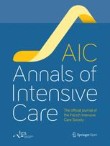Citation Impact 2023
Journal Impact Factor: 5.7
5-year Journal Impact Factor: 6.0
Source Normalized Impact per Paper (SNIP): 1.749
SCImago Journal Rank (SJR): 2.061
Speed 2023
Submission to first editorial decision (median days): 7
Submission to acceptance (median days): 91
Usage 2023
Downloads: 1,737,465
Altmetric mentions: 6,851
Platelet transfusions in cancer patients with hypoproliferative thrombocytopenia in the intensive care unit
Thrombocytopenia is a frequent finding in critically ill cancer patients for whom indications of platelet transfusions are unclear. We herein addressed the current practices in platelet transfusion and the ris...
